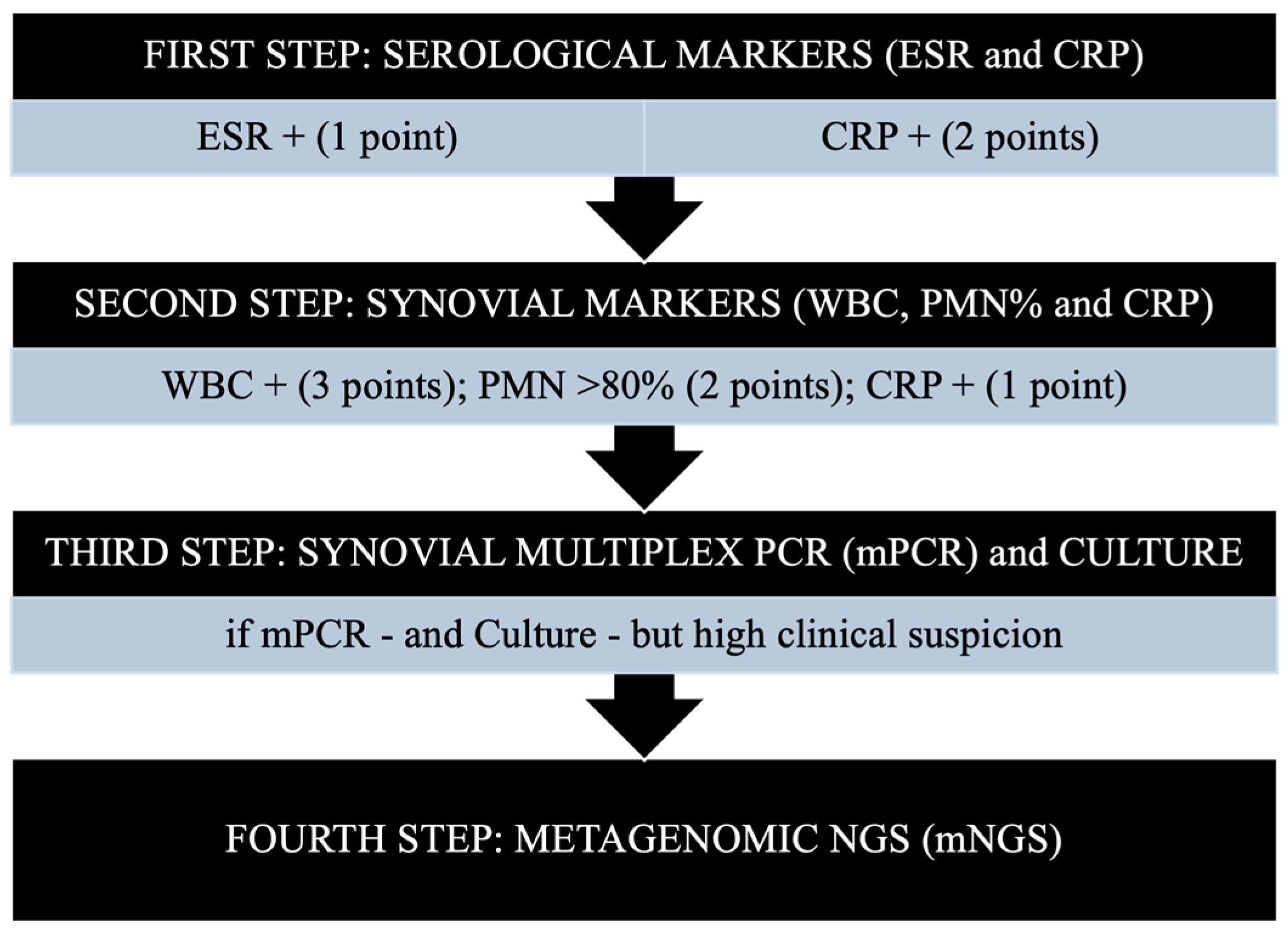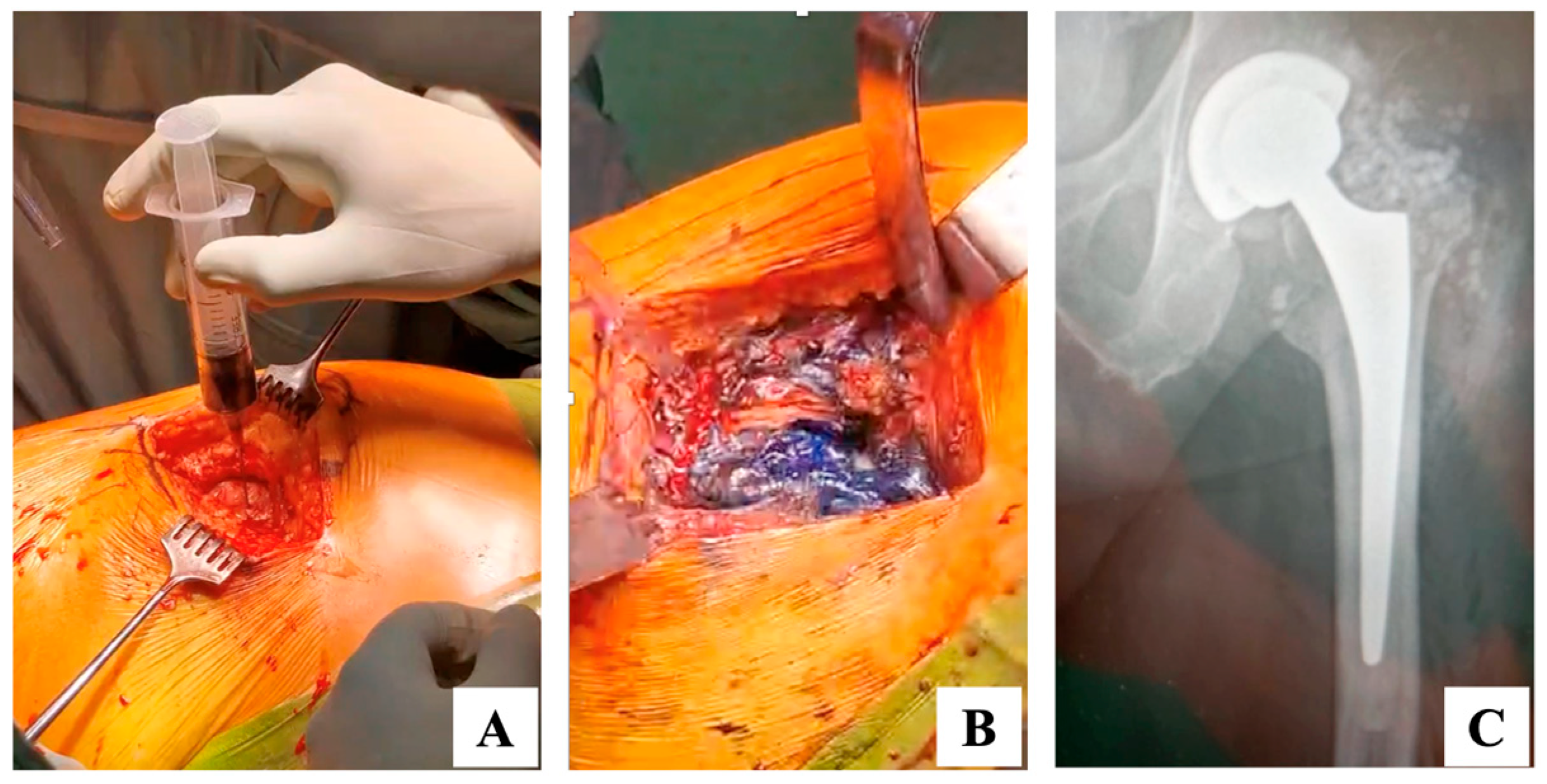Application of Molecular Diagnostics in Periprosthetic Joint Infection Microorganism Identification Following Screening Colonoscopy: A Case Report and Review of the Literature
Abstract
1. Introduction
2. Materials and Methods
3. Results
4. Discussion
5. Conclusions
Supplementary Materials
Author Contributions
Funding
Institutional Review Board Statement
Informed Consent Statement
Data Availability Statement
Conflicts of Interest
Abbreviations
| JR | Joint Replacement |
| PJI | Periprosthetic Joint Infection |
| PCR | Polymerase Chain Reaction |
| DAIR | Debridement, Antibiotics, Implant Retention |
| DAPRI | Debridement, Antibiotic Pearls, Retention of the Implant |
| THA | Total Hip Arthroplasty |
| TKA | Total Knee Arthroplasty |
| GI | Gastrointestinal |
References
- Kurtz, S.; Ong, K.; Lau, E.; Mowat, F.; Halpern, M. Projections of Primary and Revision Hip and Knee Arthroplasty in the United States from 2005 to 2030. J. Bone Jt. Surg. 2007, 89, 780–785. [Google Scholar] [CrossRef]
- Kurtz, S.M.; Lau, E.C.; Son, M.S.; Chang, E.T.; Zimmerli, W.; Parvizi, J. Are We Winning or Losing the Battle with Periprosthetic Joint Infection: Trends in Periprosthetic Joint Infection and Mortality Risk for the Medicare Population. J. Arthroplast. 2018, 33, 3238–3245. [Google Scholar] [CrossRef]
- Kamath, A.F.; Ong, K.L.; Lau, E.; Chan, V.; Vail, T.P.; Rubash, H.E.; Berry, D.J.; Bozic, K.J. Quantifying the Burden of Revision Total Joint Arthroplasty for Periprosthetic Infection. J. Arthroplast. 2015, 30, 1492–1497. [Google Scholar] [CrossRef]
- Piuzzi, N.S. Rethinking How We Define and Treat Periprosthetic Joint Infection. J. Bone Jt. Surg. 2025, 107, 664. [Google Scholar] [CrossRef]
- Wouthuyzen-Bakker, M.; Sebillotte, M.; Lomas, J.; Taylor, A.; Palomares, E.B.; Murillo, O.; Parvizi, J.; Shohat, N.; Reinoso, J.C.; Sánchez, R.E.; et al. Clinical outcome and risk factors for failure in late acute prosthetic joint infections treated with debridement and implant retention. J. Infect. 2019, 78, 40–47. [Google Scholar] [CrossRef]
- Huotari, K.; Peltola, M.; Jämsen, E. The incidence of late prosthetic joint infections. Acta Orthop. 2015, 86, 321–325. [Google Scholar] [CrossRef] [PubMed]
- Krezalek, M.A.; Alverdy, J.C. The Role of the Gut Microbiome on the Development of Surgical Site Infections. Clin. Colon. Rectal Surg. 2023, 36, 133–137. [Google Scholar] [CrossRef] [PubMed]
- Low, D.E.; Shoenut, J.P.; Kennedy, J.K.; Sharma, G.P.; Harding, G.K.; Den Boer, B.; Micflikier, A.B. Prospective assessment of risk of bacteremia with colonoscopy and polypectomy. Dig. Dis. Sci. 1987, 32, 1239–1243. [Google Scholar] [CrossRef]
- ASGE Standards of Practice Committee; Khashab, M.A.; Chithadi, K.V.; Acosta, R.D.; Bruining, D.H.; Chandrasekhara, V.; Eloubeidi, M.A.; Fanelli, R.D.; Faulx, A.L.; Fonkalsrud, L.; et al. Antibiotic prophylaxis for GI endoscopy. Gastrointest. Endosc. 2015, 81, 81–89. [Google Scholar] [CrossRef]
- Bravo, T.; Budhiparama, N.; Flynn, S.; Gaol, I.L.; Hidayat, H.; Ifran, N.N.; O’Byrne, J.; Utomo, D.N. Hip and Knee Section, Prevention, Postoperative Issues: Proceedings of International Consensus on Orthopedic Infections. J. Arthroplast. 2019, 34, S321–S323. [Google Scholar] [CrossRef] [PubMed]
- Rakow, A.; Perka, C.; Trampuz, A.; Renz, N. Origin and characteristics of haematogenous periprosthetic joint infection. Clin. Microbiol. Infect. 2019, 25, 845–850. [Google Scholar] [CrossRef]
- Longo, U.G.; De Salvatore, S.; Bandini, B.; Lalli, A.; Barillà, B.; Budhiparama, N.C.; Lustig, S. Debridement, antibiotics, and implant retention (DAIR) for the early prosthetic joint infection of total knee and hip arthroplasties: A systematic review. J. ISAKOS 2024, 9, 62–70. [Google Scholar] [CrossRef]
- Indelli, P.; Ghirardelli, S.; Valpiana, P.; Bini, L.; Festini, M.; Iannotti, F. Debridement, Antibiotic Pearls, and Retention of the Implant (DAPRI) in the Treatment of Early Periprosthetic Joint Infections: A Consecutive Series. Pathogens 2023, 12, 605. [Google Scholar] [CrossRef] [PubMed]
- Morgan, S.B.; German, G.; Abdelbary, H.; Grammatopoulos, G.; Garceau, S. Timing from Admission to Debridement, Antibiotic, and Implant Retention (DAIR) Affects Treatment Success in Total Knee Arthroplasty Periprosthetic Joint Infection. J. Arthroplast. 2025; in press. [Google Scholar]
- Qasim, S.N.; Swann, A.; Ashford, R. The DAIR (debridement, antibiotics and implant retention) procedure for infected total knee replacement—A literature review. SICOT J. 2017, 3, 2. [Google Scholar] [CrossRef] [PubMed]
- Tsai, S.W.; Mu, W.; Parvizi, J. Culture-negative periprosthetic joint infections: Do we have an issue? J. Clin. Orthop. Trauma 2024, 52, 102430. [Google Scholar] [CrossRef] [PubMed]
- Ghirardelli, S.; Scaggiante, F.; Troi, C.; Valpiana, P.; Cristofolini, G.; Aloisi, G.; Violante, B.; Russo, A.; Schaller, S.; Indelli, P.F. Multiplex PCR in septic arthritis and periprosthetic joint infections microorganism identification: Results from the application of a new molecular testing diagnostic algorithm. J. Exp. Orthop. 2024, 11, e12097. [Google Scholar] [CrossRef]
- Indelli, P.F.; Totlis, T.; Lovreković, B.; Engl, M.; Violante, B.; Skowronek, P.; Demey, G.; Ghirardelli, S.; Maci, C.; Castagna, A.; et al. Molecular diagnostics for perioperative microbial identification in periprosthetic joint infection: A scoping review and proposal of a diagnostic flow chart. J. Exp. Orthop. 2025, 12, e70263. [Google Scholar] [CrossRef]
- Esteban, J.; Salar-Vidal, L.; Schmitt, B.H.; Waggoner, A.; Laurent, F.; Abad, L.; Bauer, T.W.; Mazariegos, I.; Balada-Llasat, J.-M.; Horn, J.; et al. Multicenter evaluation of the BIOFIRE Joint Infection Panel for the detection of bacteria, yeast, and AMR genes in synovial fluid samples. J. Clin. Microbiol. 2023, 61, e0035723. [Google Scholar] [CrossRef]
- Hanusrichter, Y.; Frieler, S.; Gessmann, J.; Schulte, M.; Krejczy, M.; Schildhauer, T.; Baecker, H. Does the Implementation of the PRO-IMPLANT Foundation Treatment Algorithm Improve the Outcome of Chronic Periprosthetic Knee Infections? Mid-Term Results of a Prospective Study. Z. Orthop. Unfall. 2023, 161, 260–270. [Google Scholar] [CrossRef]
- Saadana, J.; Abdeljelil, M.; Khemili, K.; Chaouch, F.; Saad, L.; Belgacem, H.; Jellali, M.; Fekih, A.; Toumi, A.; Abid, A. Strategies for periprosthetic joint infection management in resource-limited settings: The applicability of EBJIS criteria. Int. Orthop. 2025, 49, 1027–1035. [Google Scholar] [CrossRef]
- Forlenza, E.M.; Terhune, E.B.; Higgins, J.D.D.; Jones, C.; Geller, J.A.; Della Valle, C.J. Invasive Gastrointestinal Endoscopy Following Total Joint Arthroplasty Increases the Risk for Periprosthetic Joint Infection. J. Arthroplast. 2023, 38, S394–S398.e1. [Google Scholar] [CrossRef]
- Coelho-Prabhu, N.; Oxentenko, A.S.; Osmon, D.R.; Baron, T.H.; Hanssen, A.D.; Wilson, W.R.; Steckelberg, J.M.; Baddour, L.M.; Harmsen, W.S.; Mandrekar, J.; et al. Increased risk of prosthetic joint infection associated with esophago-gastro-duodenoscopy with biopsy. Acta Orthop. 2013, 84, 82–86. [Google Scholar] [CrossRef]
- Shin, K.H.; Han, S.B.; Song, J.E. Risk of Periprosthetic Joint Infection in Patients with Total Knee Arthroplasty Undergoing Colonoscopy: A Nationwide Propensity Score Matched Study. J. Arthroplast. 2022, 37, 49–56. [Google Scholar] [CrossRef] [PubMed]
- Triesenberg, S.N.; Clark, N.M.; Kauffman, C.A. Group B Streptococcal Prosthetic Joint Infection Following Sigmoidoscopy. Clin. Infect. Dis. 1992, 15, 374–375. [Google Scholar] [CrossRef] [PubMed]
- Weiler, P.J. Late infection of a bipolar prosthesis following endoscopy. A case report. J. Bone Jt. Surg. 1995, 77, 1129–1130. [Google Scholar] [CrossRef]
- Chiu, A.K.; Malyavko, A.; Das, A.; Agarwal, A.R.; Gu, A.; Zhao, A.; Thakkar, S.C.; Campbell, J. Diagnostic and Invasive Colonoscopy Are Not Risk Factors for Revision Surgery Due to Periprosthetic Joint Infection. J. Arthroplast. 2023, 38, 1591–1596.e3. [Google Scholar] [CrossRef] [PubMed]
- Wang, Y.; Zhang, W.; Chen, B.; Huang, X.; Li, S.; Huang, Y.; Bansal, P. Gastrointestinal Endoscopy and the Risk of Prosthetic Joint Infection: A Nationwide Database Analysis. Dig. Dis. Sci. 2022, 67, 5562–5570. [Google Scholar] [CrossRef] [PubMed]
- Anderson, A.B.; Slaven, S.E.; Watson, N.L.; Cody, J.P.; McGill, R.J.; Potter, B.K.; Nealeigh, M.D. Periprosthetic Joint Infection in Patients with Arthroplasty Undergoing Perioperative Colonoscopy. JAMA Netw. Open 2024, 7, e2410123. [Google Scholar] [CrossRef]
- Krezalek, M.A.; Hyoju, S.; Zaborin, A.; Okafor, E.; Chandrasekar, L.; Bindokas, V.; Guyton, K.; Montgomery, C.P.; Daum, R.S.; Zaborina, O.; et al. Can Methicillin-resistant Staphylococcus aureus Silently Travel from the Gut to the Wound and Cause Postoperative Infection? Modeling the “Trojan Horse Hypothesis”. Ann. Surg. 2018, 267, 749–758. [Google Scholar] [CrossRef]
- Elmenawi, K.; Khan, S.; Pasqualini, I.; Visperas, A.; Deren, M.; Krebs, V.; Molloy, R.; Piuzzi, N. Colonoscopy within 6 Months before TKA May Be Associated with Worse Postoperative Outcomes, but Not Infection: A National Database Analysis. In Proceedings of the 35th Annual Open Scientific Meeting Musculoskeletal Infection Society, Jersey City, NJ, USA, 1–2 August 2025. [Google Scholar]
- Tan, T.L.; Maltenfort, M.G.; Chen, A.F.; Shahi, A.; Higuera, C.A.; Siqueira, M.; Parvizi, J. Development and Evaluation of a Preoperative Risk Calculator for Periprosthetic Joint Infection Following Total Joint Arthroplasty. J. Bone Jt. Surg. 2018, 100, 777–785. [Google Scholar] [CrossRef]
- Longo, U.G.; Lalli, A.; Bandini, B.; Angeletti, S.; Lustig, S.; Budhiparama, N.C. The influence of gut microbiome on periprosthetic joint infections: State-of-the art. J. ISAKOS 2024, 9, 353–361. [Google Scholar] [CrossRef] [PubMed]
- Bains, S.S.; Sax, O.C.; Chen, Z.; Gilson, G.A.; Nace, J.; Mont, M.A.; Delanois, R.E. Antibiotic Prophylaxis Is Often Unnecessary for Screening Colonoscopies Following Total Knee Arthroplasty. J. Arthroplast. 2023, 38, S331–S336. [Google Scholar] [CrossRef] [PubMed]
- Cashman, J.; Mortazavi, S.M.J.; Indelli, P.F.; Rele, S.; Haasper, C.; Yildiz, F.; Holland, C.T.; Lizcano, J.D.; Auñón-Rubio, Á.; Tai, D.B.G.; et al. 2025 ICM: Debridement, Antibiotics, and Implant Retention (DAIR). J. Arthroplast. 2025; epub ahead of print. [Google Scholar] [CrossRef] [PubMed]
- Seeff, L.C.; Richards, T.B.; Shapiro, J.A.; Nadel, M.R.; Manninen, D.L.; Given, L.S.; Dong, F.B.; Winges, L.D.; McKenna, M.T. How many endoscopies are performed for colorectal cancer screening? Results from CDC’s survey of endoscopic capacity. Gastroenterology 2004, 127, 1670–1677. [Google Scholar] [CrossRef] [PubMed]
- Coope, A.M.; Certain, L.; Buterin, A.; Cortés-Penfield, N.; Alkhawashki, H.M.; Suleman, L. Should antimicrobial prophylaxis be given to patients who have a joint arthroplasty in place and who are undergoing invasive procedures (e.g., dental, colonoscopy, cystoscopy, etc.)? In Proceedings of the 2025 International Consensus Meeting on Periprosthetic Joint Infections, Istanbul, Turkey, 8–10 May 2025. [Google Scholar]
- Martinazzi, B.J.; Indelli, P.F.; Azboy, I.; Babis, G.; Dikmen, G.; Flores, H.; Franceschini, M.; Goswami, K.; Han, H.S.; Huddleston, J.; et al. 2025 ICM: Diagnostic Techniques: Molecular Tests. J. Arthroplast. 2025; epub ahead of print. [Google Scholar] [CrossRef] [PubMed]



Disclaimer/Publisher’s Note: The statements, opinions and data contained in all publications are solely those of the individual author(s) and contributor(s) and not of MDPI and/or the editor(s). MDPI and/or the editor(s) disclaim responsibility for any injury to people or property resulting from any ideas, methods, instructions or products referred to in the content. |
© 2025 by the authors. Licensee MDPI, Basel, Switzerland. This article is an open access article distributed under the terms and conditions of the Creative Commons Attribution (CC BY) license (https://creativecommons.org/licenses/by/4.0/).
Share and Cite
Valpiana, P.; Salvi, A.G.; Festini Capello, M.P.; Qordja, F.; Schaller, S.; Kim, J.; Indelli, P.F. Application of Molecular Diagnostics in Periprosthetic Joint Infection Microorganism Identification Following Screening Colonoscopy: A Case Report and Review of the Literature. Prosthesis 2025, 7, 152. https://doi.org/10.3390/prosthesis7060152
Valpiana P, Salvi AG, Festini Capello MP, Qordja F, Schaller S, Kim J, Indelli PF. Application of Molecular Diagnostics in Periprosthetic Joint Infection Microorganism Identification Following Screening Colonoscopy: A Case Report and Review of the Literature. Prosthesis. 2025; 7(6):152. https://doi.org/10.3390/prosthesis7060152
Chicago/Turabian StyleValpiana, Pieralberto, Andrea Giordano Salvi, Michele Paolo Festini Capello, Fjorela Qordja, Sebastian Schaller, Jaeah Kim, and Pier Francesco Indelli. 2025. "Application of Molecular Diagnostics in Periprosthetic Joint Infection Microorganism Identification Following Screening Colonoscopy: A Case Report and Review of the Literature" Prosthesis 7, no. 6: 152. https://doi.org/10.3390/prosthesis7060152
APA StyleValpiana, P., Salvi, A. G., Festini Capello, M. P., Qordja, F., Schaller, S., Kim, J., & Indelli, P. F. (2025). Application of Molecular Diagnostics in Periprosthetic Joint Infection Microorganism Identification Following Screening Colonoscopy: A Case Report and Review of the Literature. Prosthesis, 7(6), 152. https://doi.org/10.3390/prosthesis7060152






